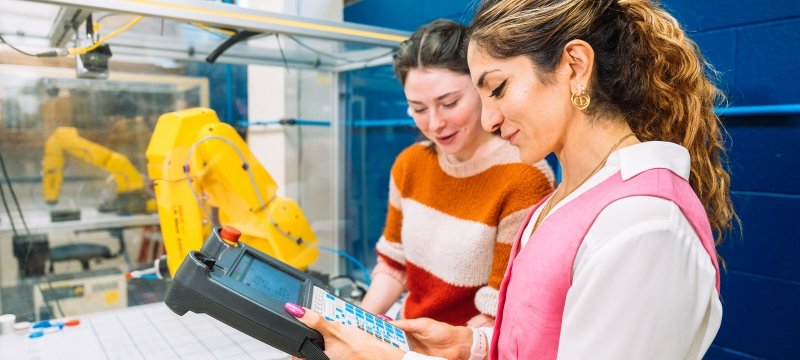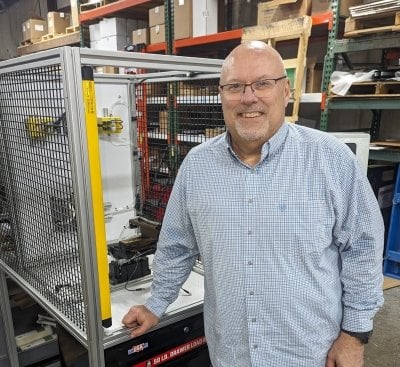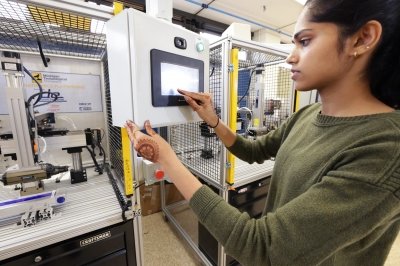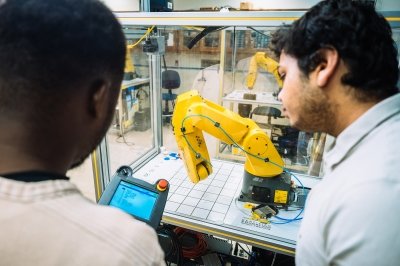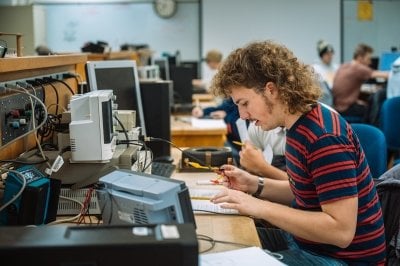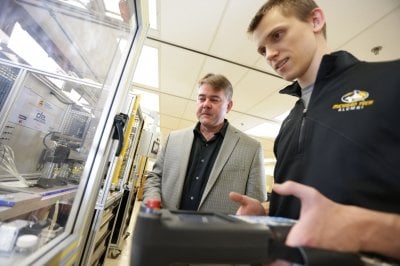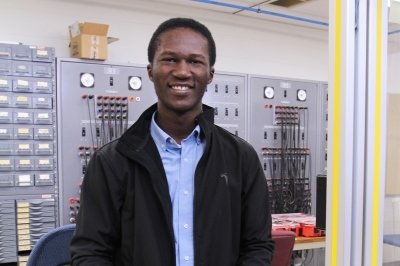Too often, machine design is based simply on cost, because money is easier to understand than the stated performances. Mechatronics provides the engineer with the ability to choose products from a menu of modular components, such as life expectancy, dynamics, and load capability.
Shaping the Future Today
By Mark Gauthier ’85, President, Donald Engineering
For as long as I can remember, the design and production of machines, devices, and processes have been bottlenecked by the separation of electrical and mechanical engineering. Mechatronics bridges this disconnect by combining electrical and mechanical engineering to create a set of engineering dynamics for the future. Over the past five years, it has progressed from a fairly unknown discipline to become part of everyday engineering conversations.
In today’s fast-paced, changing world, time has become the essence of design. Designing the process and build for a product is squeezed for time as it moves from concept to reality. The efficiencies of using skills from both mechanical and electrical engineering move processes along at a much faster pace and generate superior, higher quality outcomes. And, quality evolves alongside efficiency, setting the stage for ultimate performance.
As electronics become smaller, faster, and more intelligent, mechatronics concepts are critical. Mechatronics sheds light on the questions that need to be asked and offers a better understanding of the dynamics and controls required to make these tools run. With mechatronics, engineers have more choices for energy efficiency and quality of the device, and the knowledge to integrate tools that help reduce design time and build and increase the probability of success.
This requires logical thought processes, consideration of mechanical demands and efficiencies, and a firm grasp of how to program the sequence of operation for safety, logic, and cybersecurity. These are a lot to place on one person’s shoulders—but so are the demands of a worldwide market.
The innovative technologies used by modern manufacturers of mechatronics devices have expanded immensely. These tools and devices aid engineers, giving them choices and helping bridge the gap between the mechanical and the electrical. Without an understanding of both systems, decisions are hampered, the design process slows down, and outcomes may be jeopardized.
Too often, machine design is based simply on cost, because money is easier to understand than the stated performances. Mechatronics provides the engineer with the ability to choose products from a menu of modular components, such as life expectancy, dynamics, and load capability. Decisions can then logically be applied to the design and build to ensure the machine or device’s performance and longevity. This modularity also aids in the consideration of maintenance cost, mean time between failure, and part or performance output capability.
Efficiencies are also playing a larger role in designing and building products—and so are quality checks and the need to retain quality data. And as we produce more, we also have to document quality verification. The ability of a machine to pick up a part without a smart part checks before it continues to the next process is just adequate. To understand more fully and streamline performance on the fly, mechatronics goes further to verify holes, dimensions, surface finish, and even weight—all documented before the gripper releases the part.
Documenting this information is priceless to the producer and the customer. In some cases, it saves time and may reveal exactly what is needed to fix an issue so maintenance crews can dive into the exact location of the fault. Avoiding downtime is critical in the manufacturing process—the less time it takes to find and repair an issue, the better. Mechatronics-enabled smart devices, used in conjunction with mechanical and electrical devices, can monitor and improve performance in real time before a machine fails, limiting or eliminating surprises and allowing controlled, scheduled shutdowns.
The ability to imagine the step-by-step motion of a manufacturing process is an art form. To be able to access those skills is a gift. Knowing the process and how to make things move according to desire lays the foundation for success. The study of mechatronics helps develop these inner skills to define the ultimate questions before pencil hits paper.
The working environment is a key player in quality and efficiency. With everything moving and shifting, and multiple associates collaborating within the process, safety becomes a significant concern. Lockout/ Tagout, a system that blocks all incoming energy and discharges stored energy in the equipment, is a huge step in ensuring worker and machine safety. Mechatronics helps determine the best safety practices to eliminate trapped energy to reduce safety hazards.
New rules and regulations from the International Organization for Standardization (ISO) and American National Standards Institute (ANSI) also contribute to safety, helping build morale within the working environment and giving workers more confidence to produce better results. These standards bring safety to the forefront and develop real-life concepts to increase profits and reduce exposure to dangerous working conditions and bad press.
Today’s communications technologies let us monitor machines all over the world, allowing us to change settings on a machine running in Germany from a desk in Houghton. The danger of this access falling into the hands of a competitor or unethical hacker is a reality. Unauthorized access can degrade performance, undermine safety implementation, and compromise critical company documents and processes. With mechatronics, systems can be developed and monitored more securely.
Most importantly, mechatronics engineers should have compassion for the working environment around them. They hold the key to taking ownership and responsibility for their work. This is not about reducing overhead labor costs. It’s about making the world a better place to live.
Mechatronics engineers are passionate about what they do and how they do it. The challenges, excitement, and satisfaction of knowing you have the foundation to understand the changes are priceless. To see your work come to life is an exceptional way to enjoy your career. From the first day you knew you wanted to be an engineer, there was that desire to design, develop, and build. Now, through mechatronics, we have the curriculum to fine-tune those skills to prepare for the challenges of tomorrow. Once you understand the goal of the program, the sky is the limit—and you have to ask, “Where have you been all my life?”
Artificial intelligence and Industry 4.0 are not just buzzwords for “look what’s coming.” The future is here today—but rest assured, it will be different tomorrow. To meet industry demands and get an edge on the competition, today’s manufacturers are looking for next-generation engineering prodigies, as I like to call them. The Michigan Tech mechatronics program is preparing and empowering next-gen professionals through real-life opportunities to gain the knowledge and experience they’ll need to shape the future.
Mark Gauthier ’85 BS Electrical Engineering is the president of Donald Engineering, an engineering and distribution company headquartered in Grand Rapids, Michigan. Gauthier is a member of the Department of Applied Computing Industrial Advisory Board and a longtime supporter of Michigan Tech. Donald Engineering helped fund and build the University’s Mechatronics Playground, a state-of-the-art hands-on learning lab supporting students studying mechatronics and other degree programs at Michigan Tech.
Beginnings Track: Building the Mechatronics Workforce in the Upper Peninsula and Northern Michigan
From touchscreen tablets and phones to robotic assembly machines, today’s advanced manufacturing sector is achieving unprecedented levels of automation, flexibility, and efficiency. A key driver of this revolution is the emerging field of mechatronics, which focuses on the development and use of automation for industrial applications.
Mechatronics is expected to remain a driving force in industry, and as its smart technologies evolve, it will require a larger and more diverse STEM workforce with advanced electrical, mechanical, computer, robotics, and controls skills.
Michigan Tech, Gogebic Community College, West Shore Community College, and eight industrial partners and nonprofit organizations are collaborating to train a new generation of professionals to lead this surge in advanced manufacturing in northern Michigan and the Upper Peninsula.
Their work is supported by a three-year research and development grant from the National Science Foundation’s (NSF’s) Experiential Learning for Emerging and Novel Technologies (ExLENT) program. The $999,930 project, “Beginnings Track: Experiential Learning for the Mechatronics Workforce in the Upper Peninsula and Northern Michigan,” aims to increase interest in careers and continued education in advanced manufacturing among community college and university students, working professionals, displaced workers, and high school students.
The three-phase undertaking has begun with the development of an online mechatronics education portal (MEP) to teach theoretical knowledge in critical areas. To be launched in May 2024, the MEP comprises five self-directed learning modules.
In Phase II, participants will engage in 40 hours of hands-on, practical experiential learning on state-of-the-art equipment at Michigan Tech. In Phase III, participants will visit industrial companies in northern Michigan and the Upper Peninsula to gain firsthand knowledge of complex mechatronics systems.
Further, professional mentoring and community-building activities with academic and industry partners will help participants expand their network with industry collaborators, promote a sense of belonging, and foster a diverse community of mechatronics practitioners.
Overall, three cohorts of 20 students each will complete 120-150 hours of work through the program. A generous package of stipends and support is offered, and participants will receive a certificate of completion when they finish all phases of the training.
Another component of the grant is the research and development of a teleoperated robotics work cell at Michigan Tech. Accessible to students from anywhere in the world through an internet connection, the remote work cell will allow students to complete the same operations as a user physically present in the lab.
Alex Sergeyev, professor in the Department of Applied Computing, is the principal investigator (PI) on the $999,930 “Beginnings Track” grant. Co-PIs are Vinh Nguyen, Department of Mechanical Engineering- Engineering Mechanics; Paniz Hazaveh, Department of Applied Computing; Scott Kuhl, Department of Computer Science; David Labyak, Department of Manufacturing and Mechanical Engineering Technology; and Linda Wanless, Center for Teaching and Learning.
The nonprofit organizations engaged in the project are the Keweenaw Economic Development Alliance (KEDA), Michigan Works, and the MTEC SmartZone. The participating industrial partners are Burton EMS, Ironwood; Calumet Electronics, Calumet; FloraCraft, Ludington; GS Engineering, Houghton; Ironwood Plastics, Ironwood; REL Inc., Calumet; Metalworks, Ludington; and Orbion Space Technology, Houghton.
Faculty Bio: Alex Sergeyev, Mechatronics
Professor Alex Sergeyev, Department of Applied Computing, joined Michigan Tech as a faculty member in 2007. He holds an MS in Physics and a PhD in Electrical and Computer Engineering. Sergeyev is the graduate program director for the Master of Science in Mechatronics and director of the University’s FANUC Certified Industrial Robotic Training Center.
“I think that mechatronics is the future of engineering,” says Sergeyev. “Traditional engineering degrees will always be in high demand, but the complexity of mechatronics systems will certainly require specialists who can understand those systems from multiple dimensions."
Mechatronics is a multidisciplinary field at the intersection of mechanics, electronics, and computing. It deals with the robotics, control systems, and electromechanical systems needed in the contemporary manufacturing industry, where advanced processes are becoming more and more automated.
“Today, there are very few purely electrical or mechanical devices,” says Sergeyev. “Complicated electromechanical systems with advanced controls have become the norm. To support existing technologies and develop new, even more versatile and advanced devices, the modern engineer needs to possess skills encompassing all the pillars of mechatronics.”
Sergeyev’s physics and electrical engineering background and eight years of post-undergraduate industrial experience allow him to relate some of the theoretical mechatronics subjects to actual applications. “Knowing the subject is key. An ability to relate the theory to industrial applications makes teaching a subject more interesting and productive,” he says.
His expectations for students are high. “I’m always open with the students but also very straight in my requirements. Sometimes, they don’t like it, but the truth of life is that they must be ready to implement their skills on day one once they join the industry. It is a very demanding task, and I want them to be ready for that.”
Sergeyev recalls a School of Technology Industrial Advisory Board (IAB) meeting about 15 years ago at which an IAB member proposed incorporating industrial robotics into the curriculum.
“None of the faculty had expertise in industrial robotics at that time, but in discussions, it became clear that we should consider incorporating it in our BS in Electrical Engineering Technology (EET) program curricula,” says Sergeyev. “We saw a massive trend in the growth of industrial robots in manufacturing and other industrial sectors. Providing these skills was a must for graduates of Michigan Tech, and it would make the EET program stand out.”
Sergeyev took on the challenge to lead this endeavor. “It was not easy and required months of training at FANUC America—the largest manufacturer of industrial robots and source for self-learning of the subject,” he says.
Learning even more, Sergeyev experienced firsthand how advanced manufacturing is taught in Europe during a sabbatical leave at Aarhus School of Marine and Technical Engineering in Denmark, and later during work with faculty and students at Heilbronn University of Applied Sciences, Germany.
“In Europe, I was immersed in the field of mechatronics and the electrical, mechanical, controls, robotics automation, and computing fields of study. These extraordinary educational and research experiences encouraged me to introduce and launch the mechatronics degrees at Michigan Tech,” says Sergeyev.
Today, the mechatronics bachelor’s and master’s programs at Tech are growing rapidly. Graduates are in high demand, and they are hired by Tesla, General Motors, Ford, and many other leading manufacturing companies.
“All of this would not be possible without the support of the exemplary MTU faculty, staff, and administration, who are pushing the envelope of this rapidly growing field,” says Sergeyev. “I am very proud to be part of this team that is fostering our educational programs at Michigan Tech.”
Graduate Profile: Joshua Olusola, MS in Mechatronics
“My Michigan Tech education gave me the skill sets needed to pursue a field I enjoy and find purpose in,” says Joshua Olusola, who completed his Master of Science in Mechatronics in spring 2023.
Olusola completed his BS in Mechanical Engineering in 2019 at the University of Ibadan, Nigeria. In his final year of undergraduate studies, he interned at an industrial automation company, which spurred his interest in mechatronics. After two years of postgraduate employment, he was ready to pursue a graduate degree. And when a friend shared a research opportunity at Michigan Tech, Olusola found himself on the University’s website.
“I was super excited when I saw the mechatronics program,” says Olusola. “And not only were they teaching robotics, they were teaching industrial robotics using FANUC robots and industrial controls using Allen-Bradley PLCs (programmable logic controllers)! Those are the big products when it comes to industrial automation.”
Olusola’s research into Michigan Tech’s mechatronics master’s program confirmed that the course structure and lab software and equipment were consistent with the skills needed by companies in the industry. “This was what drew me to the program,” he says.
Olusola is now working at Tesla Inc. as a manufacturing controls and automation engineer at the company’s Gigafactory based in Austin, Texas. There, he supports a team developing manufacturing lines for battery packs and drive units.
Olusola is currently focused on pursuing professional certifications relevant to the field. However, further down the line, he says he would like to pursue an MBA and/or a PhD in robotics.
Michigan Technological University is an R1 public research university founded in 1885 in Houghton, and is home to nearly 7,500 students from more than 60 countries around the world. Consistently ranked among the best universities in the country for return on investment, Michigan's flagship technological university offers more than 185 undergraduate and graduate degree programs in science and technology, engineering, computing, forestry, business, health professions, humanities, mathematics, social sciences, and the arts. The rural campus is situated just miles from Lake Superior in Michigan's Upper Peninsula, offering year-round opportunities for outdoor adventure.
